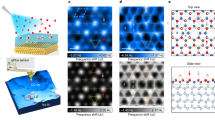Abstract
MIXED-LAYER minerals of illite and montmorillonite have been known for more than a decade now, and new examples are constantly being reported1. The identification of these minerals is based largely on X-ray examination using the tables and curves of Brown and MacEwan2 or the method of MacEwan3 for random structures; the methods for ordered structures are more direct. Most workers publish differential thermal curves as supporting evidence for the presence of an inter layered structure, and in these curves there are usually two endothermic peaks in the region between 500° and 700° C, which are taken to represent loss of hydroxyl water from the separate illite and montmorillonite layers. However, a detailed examination of published and unpublished differential thermal curves of these materials shows that the sizes of the endothermic peaks in the 500°–700° C. region bear no relation to the proportion of illite to montmorillonite found by X-ray examination. Order can be attained only by dividing the curves into two series, in one of which the mala endothermic peak lies between 525° and 625° C. and in the other between 650° and 725° C. The curves in each series still bear no relation to the proportion of illite and montmorillonite, but there is an important structural difference between the groups not revealed by X-ray examination which appears to be of wide significance.
This is a preview of subscription content, access via your institution
Access options
Subscribe to this journal
Receive 51 print issues and online access
$199.00 per year
only $3.90 per issue
Buy this article
- Purchase on Springer Link
- Instant access to full article PDF
Prices may be subject to local taxes which are calculated during checkout
Similar content being viewed by others
References
Bystrom, A. M., Nature, 173, 783 (1954). Cole, W. F., and Carthew, A. R., J. Roy. Soc. Tas., 87, 1 (1953). Heystek, H., Min. Mag., 30, 400 (1954). Weaver, C. E., Bull. Geol. Soc. Amer., 64, 921 (1953).
Brown, G., and MacEwan, D. M. C., in “X-Ray Identification and Structures of Clay Minerals”, edit. G. W. Brindley, 266 (1950).
MacEwan, D. M. C., Nature, 172, 364 (1953).
Mackenzie, R. C., Walker, G. F., and Hart, R., Min. Mag., 28, 704 (1949).
Bose, A. K., and Sengupta, P., Nature, 174, 40 (1954).
Hill, R. D., Trans. Brit. Ceram. Soc., 52, 589 (1953).
Kerr, P. F., Kulp, J. L., and Hamilton, P. K., “Differential Thermal Analysis of Reference Clay Mineral Specimens”, Report 3, American Petroleum Institute Project 49 (Columbia University, New York, 1949).
Author information
Authors and Affiliations
Rights and permissions
About this article
Cite this article
COLE, W. Interpretation of Differential Thermal Curves of Mixed-layer Minerals of Illite and Montmorillonite. Nature 175, 384–385 (1955). https://doi.org/10.1038/175384a0
Issue Date:
DOI: https://doi.org/10.1038/175384a0
This article is cited by
-
Differential thermal analysis of montmorillonite
Journal of Thermal Analysis (1996)
Comments
By submitting a comment you agree to abide by our Terms and Community Guidelines. If you find something abusive or that does not comply with our terms or guidelines please flag it as inappropriate.



